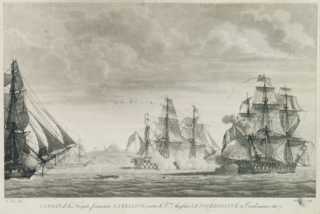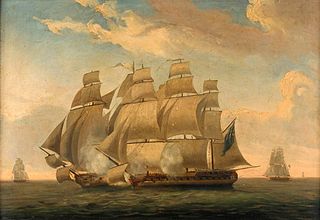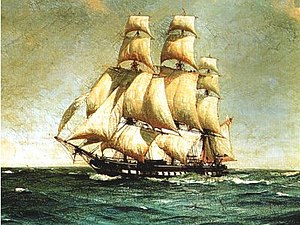
The Océan-class ships of the line were a series of 118-gun three-decker ships of the line of the French Navy, designed by engineer Jacques-Noël Sané. Fifteen were completed from 1788 on, with the last one entering service in 1854; a sixteenth was never completed, and four more were never laid down.

The Minerva-class sailing frigates were a series of four ships built to a 1778 design by Sir Edward Hunt, which served in the Royal Navy during the latter decades of the eighteenth century.

The Intrepid-class ships of the line were a class of fifteen 64-gun third rates, designed for the Royal Navy by Sir John Williams. His design, approved on 18 December 1765, was slightly smaller than Sir Thomas Slade's contemporary Worcester-class design of the same year, against which it was evaluated competitively. Following the prototype, four more ships were ordered in 1767–69, and a further ten between 1771 and 1779.

The Téméraire-class ships of the line were a class of a hundred and twenty 74-gun ships of the line ordered between 1782 and 1813 for the French navy or its attached navies in dependent (French-occupied) territories. Although a few of these were cancelled, the type was and remains the most numerous class of capital ship ever built to a single design.
The Annibal class was a class of two 74-gun ships of the French Navy. The type was one of the first achievements of Jacques-Noël Sané. His first design - on 24 November 1777 - was for a ship of 166 pieds length, but he produced an amended design on 10 January 1779 for the Annibal, and a further amended design on 3 March 1780 for her near-sister Northumberland. Both ships were captured during the Fourth Battle of Ushant on 1 June 1794 off Ushant, and were added to but never commissioned into the British Navy.

The Tonnant class was a series of eight 80-gun ships of the line designed in 1787 by Jacques-Noël Sané, whose plans for the prototype were approved on 29 September 1787. With sixteen gunports on the lower deck on each side these were the most effective two-deckers of their era. Their broadside of 1,102 livres equated to 1,190 British pounds weight, over 50% more than the standard British 74-gun ship, and even greater than that of a British 100-gun three-decker.

The Enterprise-class frigates were the final class of 28-gun sailing frigates of the sixth-rate to be produced for the Royal Navy. These twenty-seven vessels were designed in 1770 by John Williams. A first batch of five ships were ordered as part of the programme sparked by the Falklands Islands emergency. Two ships were built by contract in private shipyards, while three others were constructed in the Royal Dockyards using foreign oak.

The Iphigénie class was a group of nine 32-gun/12-pounder frigates of the French Navy, built during the late 1770s at Lorient and Saint Malo. They were designed by Léon Guignace. The seven built at Saint Malo were initially numbered Nos. 1 – 7 respectively, and not given names until October 1777 and the start of 1778 ; all seven were captured by the British Navy between 1779 and the end of 1800. Of the two built at Lorient, the Spanish captured one, and a storm wrecked the other.

The Sibylle class was a class of five 32-gun sail frigates designed by Jacques-Noël Sané and built for the French Navy in the late 1770s. They carried 26 x 12-pounder guns on the upper deck and 6 x 8-pounder guns on the forecastle and quarter deck.

The Romaine class was a class of nine frigates of the French Navy, designed in 1794 by Pierre-Alexandre Forfait. They were originally designated as "bomb-frigates" and were intended to carry a main armament of twenty 24-pounder guns and a 12-inch mortar mounted on a turntable in front of the mizzen mast. Experience quickly led to the mortars being removed, and the 24-pounders were replaced by 18-pounder guns. The ships also featured a shot furnace, but they proved impractical, dangerous to the ships themselves, and were later discarded. A further eleven ships ordered to this design in 1794 were not built, or were completed to altered designs.

The Roebuck-class ship was a class of twenty 44-gun sailing two-decker warships of the Royal Navy. The class carried two complete decks of guns, a lower battery of 18-pounders and an upper battery of 9-pounders. This battery enabled the vessel to deliver a broadside of 285 pounds. Most were constructed for service during the American Revolutionary War but continued to serve thereafter. By 1793 five were still on the active list. Ten were hospital ships, troopships or storeships. As troopships or storeships they had the guns on their lower deck removed. Many of the vessels in the class survived to take part in the Napoleonic Wars. In all, maritime incidents claimed five ships in the class and war claimed three.

The Nymphe class was a class of six 40-gun frigates of the French Navy, designed in 1781 by Pierre-Augustin Lamothe. The prototype (Nymphe) was one of the earliest 18 pounders (8.2 kg) armed frigates.
The Magnanime class was a class of two 74-gun ships of the line built for France in the late 1770s. They were designed by Jean-Denis Chevillard, and both were constructed at Rochefort Dockyard.
The Minerve class was a type of 40-gun frigate of the French Navy, carrying 18-pounder long guns as their main armament. Six ships of this type were built at Toulon Dockyard, and launched between 1782 and 1794. The frigates served the French Navy briefly during the French Revolutionary Wars. The Royal Navy captured all six between 1793 and 1799 and took them into service, with all but one serving in the Napoleonic Wars, and some thereafter.

The Pégase class was a class of 74-gun ships of the French Navy, built to a common design by naval constructor Antoine Groignard. It comprised six ships, all ordered during 1781 and all named on 13 July 1781.
The Argonaute class was a class of two 74-gun ships of the French Navy, built to a common design by naval constructor François-Guillaume Clairin-Deslauriers. The design was lengthened by 4feet 9½ inches from the designer's previous Scipion class, which had been found to lack stability. The designer died on 10 October 1780, and the construction of these ships was completed by Jean-Denis Chevillard, who was appointed his successor as ingénieur-constructeur en chef at that dockyard in July 1781.

The Charmante class was a group of five 32-gun/12-pounder frigates of the French Navy, built during the late 1770s at Brest Nantes and Saint Malo. They were designed by Jean-Denis Chevillard. Of the five ships, two were wrecked, two were captured by the British, and one by the Spanish.













